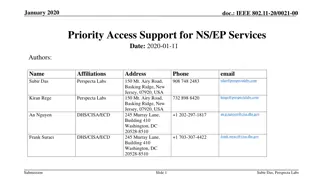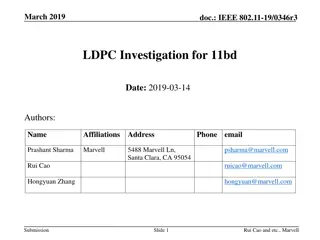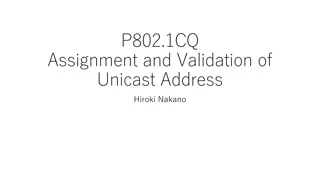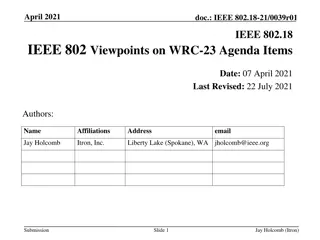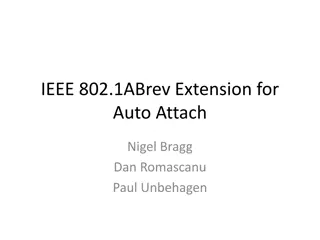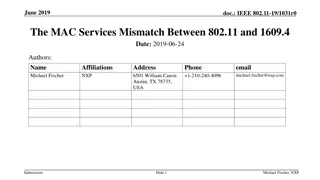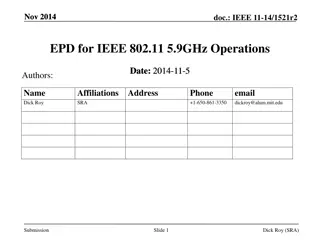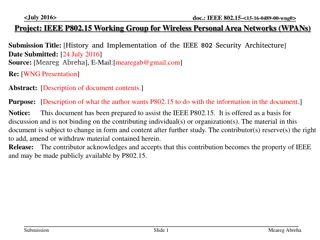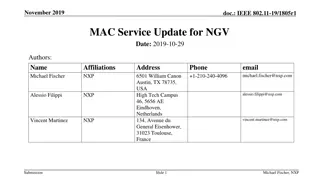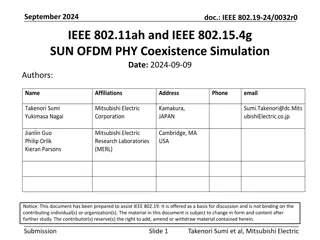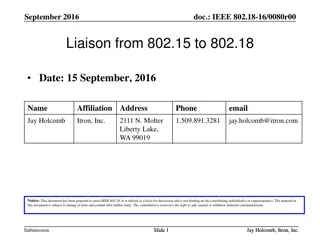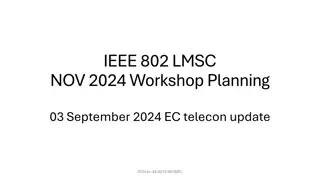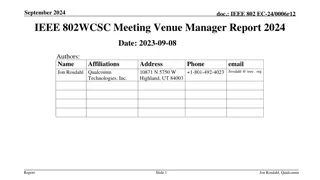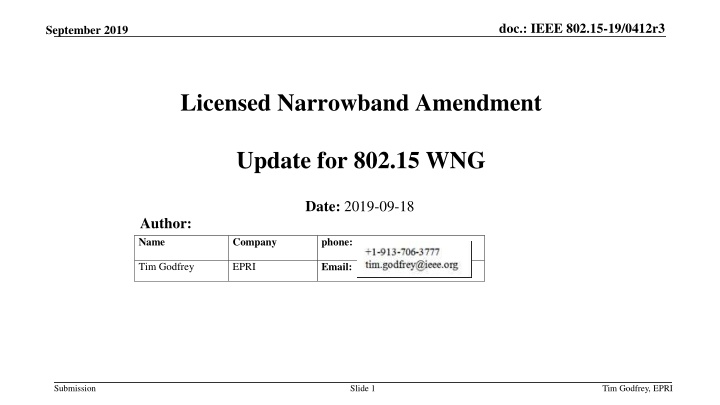
IEEE 802.15-19/0412r3 September 2019 Update
This document outlines the goals, potential participants, and the path forward for the IEEE 802.15-19/0412r3 amendment project, focusing on narrowband spectrum support. The activities within IEEE 802 to date are also discussed, highlighting the steps taken to initiate the project.
Download Presentation

Please find below an Image/Link to download the presentation.
The content on the website is provided AS IS for your information and personal use only. It may not be sold, licensed, or shared on other websites without obtaining consent from the author. If you encounter any issues during the download, it is possible that the publisher has removed the file from their server.
You are allowed to download the files provided on this website for personal or commercial use, subject to the condition that they are used lawfully. All files are the property of their respective owners.
The content on the website is provided AS IS for your information and personal use only. It may not be sold, licensed, or shared on other websites without obtaining consent from the author.
E N D
Presentation Transcript
doc.: IEEE 802.15-19/0412r3 September 2019 Licensed Narrowband Amendment Update for 802.15 WNG Date: 2019-09-18 Author: Name Company phone: Email: Tim Godfrey EPRI Submission Slide 1 Tim Godfrey, EPRI
doc.: IEEE 802.15-19/0412r3 September 2019 Goals of Amendment Project A group of industry stakeholders have come together to support amending IEEE 802.16-2017 to: Provide support for narrower channels of operation Aggregate discontinuous narrowband spectrum. This is needed to address operations in the smaller spectrum allocations that electric utilities and other critical infrastructure industries have access to The 802.16s amendment defined operation between 1.25 MHz and 100 KHz. This amendment would define operation to as narrow as 5 KHz channels Submission Slide 2 Tim Godfrey, EPRI
doc.: IEEE 802.15-19/0412r3 September 2019 Potential Participants Craig Tedrow Leonhard Korowajczuk Daryl Parker GE MDS Celplan Alligator Telewave WCC of AAR Select Spectrum CML Microcircuits BNSF Enterprise Products/ENTELEC UTC Connexus Energy EWA Motorola Solutions NPPD (representing UTC) Ondas Chevron WiMAX Forum Through a series of meetings at Utility, Oil, Gas, and Railroad conferences the following individuals and affiliations have expressed intentions to participate in the project Tom Peters Bob Finch Daoud Serang Zach Smith Jerry Roberts Klaus Bender Tom Guttormson Mark Crosby Scott Schoepel Lon Renner Guy Simpson/Menashe Shahar Rick Smith Rich Hawkins This group came to me to provide guidance on initiating the amendment process. Submission Slide 3 Tim Godfrey, EPRI
doc.: IEEE 802.15-19/0412r3 September 2019 Path Forward To proceed with this amendment, there are two options: 1: Bring 802.16 out of hibernation as a Working Group The prior WG officers are not able to resume their pre-hibernation roles, so it would be a re-start with new people Most of the people with 802.16 expertise are no longer active or are working in other areas 2: Create in 802.15 Task Group to work on the project Scope of the project is aligned with Wireless Specialty Networks Task Group could operate as 802.15.16, similar to 802.15.22 Teleconference discussion on moving project into 802.15 Participants and stakeholders are in favor this is the preferred path Submission Slide 4 Tim Godfrey, EPRI
doc.: IEEE 802.15-19/0412r3 September 2019 Activity within IEEE 802 to Date The potential project was discussed informally with EC members at the July Plenary The 802 Chair suggested the 802.24 TAG should host Teleconferences to provide a forum for discussion and PAR / CSD development Two teleconferences have been hosted by 802.24 Minutes and Draft PAR and CSD posted on Mentor 802.24-19-0021r0 802.24-19-0022r3 802.24-19-0023r0 802.24-19-0024r1 Minutes of August 5th Teleconference Draft PAR Minutes of Sept 3rd Teleconference Draft CSD Submission Slide 5 Tim Godfrey, EPRI
doc.: IEEE 802.15-19/0412r3 September 2019 Scope Statement from Draft PAR 5.2.b. Scope of the project: This project specifies WirelessMAN TDD operation in licensed spectrum with channel bandwidths greater than or equal to 5 kHz and less than 1.25 MHz. The amendment will be frequency agnostic but will focus on spectrum less than 2 GHz. The project will introduce amendments to the IEEE Std 802.16 as required to support narrower channel widths and other functionality as needed to support operation in adjacent and non-adjacent Private Land Mobile Radio (PLMR) channels. The range and data rate supported by the narrower channels are commensurate with those of the base standard, as scaled by the reduced channel bandwidth. The project will add a modified air interface protocol at the PHY and MAC layers. Submission Slide 6 Tim Godfrey, EPRI
doc.: IEEE 802.15-19/0412r3 September 2019 Need Statement from Draft PAR 5.5 Need for the Project: Mission critical entities have a strong preference for private, licensed networks in for their data communications needs. Licensed channels from 5 kHz to 1 MHz are available from the FCC and other regulators or in the secondary markets at a lower cost than commercial channels. Example operating frequencies include 160 MHz, 450 MHz, 700 MHz, and 900 MHz. The base standard, and thus this amendment, is not limited to specific operating frequencies. Furthermore, VHF/UHF channels have superior propagation characteristics requiring less infrastructure and are capable of meeting capacity needs of private networks. The amendment facilitates the development of innovative, cost-effective, and interoperable multivendor products for private licensed wireless access systems for mission critical networks. Applications include smart grids supporting generation, transmission, and distribution; field area networks; smart fields and smart pipes for oil and gas; intelligent transportation for rail systems; and federal, state and local uses for homeland security, environmental and seismic monitoring and military communications. Submission Slide 7 Tim Godfrey, EPRI
doc.: IEEE 802.15-19/0412r3 September 2019 Uniqueness How are the desired use cases different than 802.15.4 SUN? Operation in Licensed Spectrum Point to Multi-point with handover between base stations. Relaying, but no mesh Fully Scheduled MAC supporting low, bounded latency How are the desired use cases different than 802.15.4 LMR RCC? More flexibility in frequency bands and channel sizes Higher data rates than RCC LMR PHY Fully Scheduled MAC supporting low, bounded latency Submission Slide 8 Tim Godfrey, EPRI
Slide 9 doc.: IEEE 802.15-19/0412r3 September 2019 Plan as discussed at September Interim Continue conducting PAR/CSD development in 802.24 Approve the PAR/CSD this week (with editorial license) Conduct motion to approve on Wednesday Send to Roger Marks for review Change PAR WG names to 802.24 as the TAG developing the PAR Circulate to EC to update them on the strategy. PAR developed by 802.24, assigned to 802.15 October 1st EC Teleconference Request agenda item to brief EC on plan for PAR 802.24 will submit PAR to EC by November plenary deadline 802.24 will provide a forum in November for addressing PAR comments EC will assign project to 802.15. Form Task Group 802.15.16 Attendees of first Task Group meeting will be granted 802.15 voting rights Submission Tim Godfrey, EPRI




